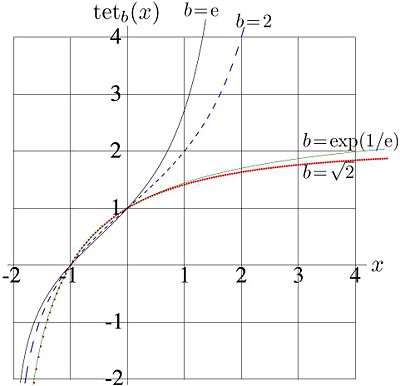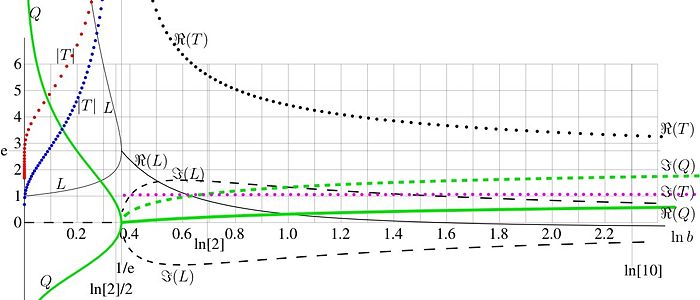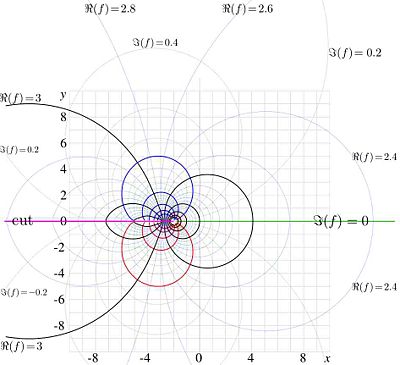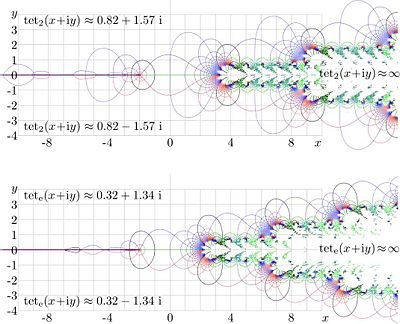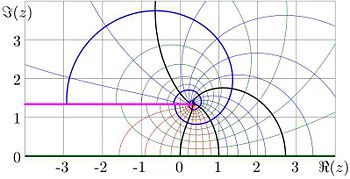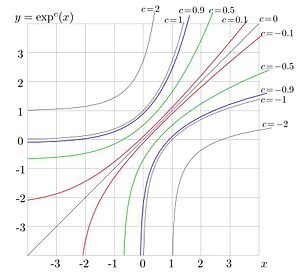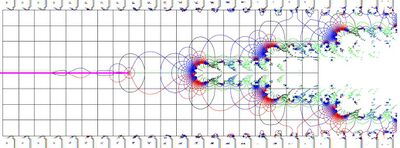Tetration
Tetration is fastly growing mathematical function, which was introduced in XX century and suggested for representation of huge numbers in mathematics of computation. For positive integer values of its argument , tetration on base can be defined with . For real values of the argument and various values of base , this is plotted in FIg.1.
Up to year 2008, this function is not listed among elementary functions, it is not implemented in programming languages and it is not used for the internal representation of data in computers.
In this article, the generalizaiton of tetration for complex (and, in particular, real) values of its argument is described. This tetration is used to construct the holomorphic extension of the iteratied exponential for the case of non-integer values of the number of iterations.
Definiton
For real , Tetration on the base is function of complex variable, which is holomorphic at least in the range , bounded in the range , and satisfies conditions
at least within range .
The definition above generalizes the definitions suggested recently for the specific cases of base [1] and [2].
Etymology
Creation of word tetration is attributed to Englidh mathematician Reuben Louis Goodstein [3] [4]. This name indicates, that this operation is fourth (id est, tetra) in the hierarchy of operations after summation, multiplication, and exponentiation. In principle, one can define "pentation", "sextation", "septation" in the simlar manner, although tetration, perhaps, already has growth fast enough for the requests of XXI century.
Real values of the arguments, general view
Examples of behavior of this function at the real axis are shown in figure 1 for values , , , and for . It has logarithmic singularity at , and it is monotonously increasing function.
At tetration approaches its limiting value as , and .
Fast growth and application
At tetration grows faster than any exponential function. For this reason the tetration is suggested for the representation of huge numbers in mathematics of computation[5]. A number, that cannot be stored as floating point, could be represented as for some standard value of (for example, or ) and relatively moderate value of . The analytic properties of tetration could be used for the implementation of arithmetic operations with huge numbers without to convert them to the floating point representation.
Integer values of the argument
For integer , tetration can be interpreted as iterated exponential:
and so on; then, the argument of tetration can be interpreted as number of exponentiations of unity. From definition it follows, that
and
Relation with the Ackermann function
At base , tetration is related to the Ackermann function [6]
where Ackermann function is defined for the non-negative integer values of its arguments with equations
The generalization of the 4th Ackermann funciton for the complex values of is described in the preprint [2] . Construction of such holomorphic extension is equivalent to construction of tetration for the base .
Asymptotic behavior and properties of tetration
The analytic extension of tetration grows fast along the real axis of the complex -plane, at least for some values of base . However, it does not grow infinitely in the direction of imaginary axis. The asymptotic behavior determines the basic properties of tetration.
The exponential convergence of discrete interation of logarithm corresponds to the exponential asymptotic behavior
where
- ,
and are fixed complex numbers, and is eigenvalue of logarithm, solution of equation
- .
Solutions of this equation are called fixed points of logarithm.
Fixed points of logarithm
Three examples of graphical solution of equation for fixed points of logarithm are shown in figure 2 for , , and .
The black line shows function in the plane. The colored curves show function for cases (red), (green), and (blue).
At , there exist 2 solutions, and .
At there exist one solution .
and , there are no real solutions.
In general,
- at there are two real solutions
- at , there is one soluition, and
- at there esist two solutions, but they are complex.
In particular,
at
, the solutions are
and
.
At
, the solutions are
and
.
At , the solutions are
and
.
Few hundred straightforward iterations of equation (14) are sufficient to get the error smaller than the last decimal digit in the approximations above.
Basic properties
The solutions and of equation (14) are plotted in figure 3 versus with thin black lines. Let , and only at , the equality takes place. Basic properties of tetration are determined by the base . The main parameters versus are plotted in figure 3. The thin black solid curve at represents the real part of the solutions and of (14); the thin black dashed curve represents the two options for the imaginary part; the two solutions are complex conjugaitons of each other. Requirement of definition of tetration determine the asymptotic of the solution. Parameter tetermines periodicity of quasi-periodicity of tetration. The two solutions for <\math>Q</math>are shown in figure 3 with green lines.
At both solutons for <\math>Q</math> are real. The negative corresponds to tetration, decaying to the asymptotic value in the direction of real axis; positive </math>Q</math> corresponds to the solution growing along the real axis. At the real axix, such a solution remains larger than unity; this does not allow to satisfy confition . Therefore, only one negative corresponds to the asymptotic behavior of tetration.
At , both options for are mutually complex conjugate. The real part is shown thif thick green line; one option of the imaginary part is shown with dashed line.
Possibilities for the period (or quasi-period) are shown in Figure 3 with fotted lines. At , only "negative" period forresponds to tetration. At , the periodicity can be achieved only asymptotically; and is quasi-period. The real part of quasi-period is markes with black dotted line; one of two options tor the imaginary part is marked with pink dotted line.
Generally, at , tetration is periodic; the period is pure imaginary.
At , tetration is not periodic, and no exponential asymptotic exist.
, tetration is quasi–periodic, the quasi-period in the upper complex half-plane is conjugate to that in the lower complex half-plane. The larger is base , the shorter is quasi-period. As the quasi-periods are complex conjugated, the quasi-periodicity takes place away from the real axis.
Evaluation of tetration
As the asymptoric of tetration is crutually depend of base in ficinity of value , the evaluation procidure is different foe the cases , , and , and should be considered serapately.
Case
At , the period is imaginary. Period with smallest modulus corresponds to the solution that is unity at the origen of coordinates. For , function is shown in figure 4 with levels of constant real part and levels of constant imaginary part. Levels and levels aew shown with thick lines. Intermediate levels are shown with thin lines. There are branch points at ; the cut lines are . For this value of base, the period
- Failed to parse (syntax error): {\displaystyle T=\frac{2\pi}{\ln^2(2)}\approx −17.1431481793548471041794 ~\mathrm{i}} .
There is cut at , ; although the jump at this cut reduces at the increase of . In such a way, the function approaches its limiting value almost everywhere, although there is set of singularities at negiative integer values of .
The solution follows asymptotic at large values of real part of the argument, exponentially approaching the limiting value. In particular, for , this maximum limiting value is in the left hand side of the figure, and to its minimum llimiting value in the right hand side. For , these limiting values are and .
The trace of the solution along the real axis corresponds to the red dotted curve in Figure 1. Other solutions of the recursive equation , that may grow up along the real axis, can be constructed in the similar way, but they do not satisfy criteria formulated in the definition of tetration; in particular, .
Case
At , the liniting value , and, asymptotically,
The function is shown in figure 5.
Levels are shown with thick black lines.
Levels are shown with thick red lines.
Levels are shown with thick blue lines.
Intermediate levels are shown with thin lines.
There is cut at , , but the hump of the function at the cut reduces as reduces, id est, with increasing of . In suchg a way, everywhere, at , the function approaches its limiting value . almost everywhere, although there is set of singularities at negiative integer values of .
Behavior of this function at real values of argument is shown in Figure 1 with thin solid line. Other solutions of the recursive equation can be constructed in the ximilar way; they may grow up along the real axis, but they do not satisfy criteria formulated in the definition of tetration; in particular, .
Case
At , tetration is asymptotically periodic. It exponentially decays to the fixed points and in th eupper and lower halfplane. This allows to express it through its values along the imaginary axis, using the Cauchi integral. [1].
For the base and tetration is plotted in figure 6. Levels and are drawn with thick lines. The function has logarithmic singulatiry at point -2 and cut at real values of the argument, smaller than -2. In the right hand side, symbols mean huge values that cannot be stored in the conventional floating point representation (logarithm, mantissa). In the upper left and lower left part of eath graphic, the function approaches its asymptotic values and . Function is quasi-periodic; the same fractal structure reproduces again and again at the translation of argument with quasiperiod in the upper halfplane and in the lower halfplane.
There is cut at , . The jump of the function at this cut approaches almost everywhere, although there is set of singularities at negiative integer values of .
Along the real axis, tetration for this values of base is plotted also in figure 1 with thick solid and dashed lines.
Behavior along the real axis
The growth of tetration along the real axis is crutially determient by its base.
At the growth is limited by the minimal of the limiting values . Tetration approaches this limiting value exponentially.
At , the growth is limited by the fixerd point . Tetration approaches this limiting value as rational function.
The growing-up holomorphic solution of equation can be constructed in the similar way also at
, but at the real axis, such a solution remains larger than unity, and the condition cannot be satiscied. Therefore, this solution cannot be interpreted as extension of
iterative exponentiation for non-integer number of exponentiations; in this sense, such a solution is not a tetration.
Tetration shows explosively-fast growth along the real axis only at values .
Inverse of tetration
The inverse of tetration can be performed using the Newton method, solving equation , leading to
- .
The inverse function has branchpints and . For the kslog, at base , shown in the figure 7, the cuts are placed horisontaly, along the lines
- , .
Due to the symmetry , it is sufficient to plot only half of the complex plane.
The mapping with function kslog is shown in figure 8. For in the shaded region, the relation
takes place. The upper part of the complex plane is mapped into the upper halfplane, and the lower halfplane is mapped to the lower halfplane. The real axis is mapped into the halfline . The fixed points is mapped to imaginary infinity, following the shadower strip.
In figure 8, the images of the grid lines and images of the grid lines are shown. These curves reproduce levels and shown in figure 6 for .
Together, the pair of functions tet and kslog allow to evaluate any iteration (including negative, fractional and even complex) of the exponential finction.
Iterated exponential and
Pre-historic approach to the iterated exponential
Especially interesting is the case of iteration of natural exponential, id est, . Existence of the fractional iteration, and, in particular, existence of operation was demonstrated in 1950 by H.Kneser. [7]. However, that time, there was no computer facility for the evlauation of such an exotic function that ; perhaps, just absence of an apropriate plotter did not allow Kneser to plot the distribution of fractal exponential function in the complex plane for various values of , shown in Fig.9.
The Implementation through the tetration
Holomorphic tetration allows to extend the iterated exponential
For non-integer values of . It can be defined as
If in the notation the superscript is omitted, it is assumed to be unity; for example . If the subscript is omitted, it is assumed to be , id est,
Iterated exponential in the complex plane
Function is shown in figure 9 with levels of constant real part and levels of constant imaginary part. Levels and are drown with thick lines. Red corresponds to a negative value of the real or the imaginaryt part, black corresponds to zero, and blue corresponds to the positeive values. Levels are shown with thin red lines. Levels are shown with thin green lines. Levels and Levels are marked with thick green lines, where is fixed point of logarithm. At non-integer values of , and are branch points of function ; in figure, the cut is placed parallel to the real axis. At there is an additional cut which goes along the negative part of the real axis. In the figure, the cuts are marked with pink lines.
Iterated exponential of a real argument
For real values of the argument, function is ploted in figure 10 versus for values
.
in programming languages, inverse function of exp is called log.
For logarithm on base e, notation ln is also used. In particular, , and so on.
At least for the real and big enough , the relation holds, which is qute analogous of relations and . However, at negative or negative , value should be big enough, that and and are defined, see figure 10. For example, at , we need . In particular, at , , we have .
Applicaiton of iterated exponential
The iterated exponential, that can be implemented with holomorphic tetration, may have various applicaitons. In particular, The at </math>0\!<\!c\!<\!1</math> could describe a process that grows faster than any polynomial, but slower than any exponential. In such a way, the iterated exponential, at the proper implementation, should greatley extend the abilities of fast and precise fitting of functions. This is just analogy of function which, at fractal values of , may be good for description of a function that grows faster than any linear function but slower than any quadratic function.
Similar functions
WIthdrowal of some of requirements from the definition of tetration allows the huge variety of similar functions.
Withdrowal of the requirement and allows the solution by Kneser [7], which is entire and also could be used to buld up various powers of the exponential; in particular, .
WIthdrowal of condition allows to construct solutions, similar to the growing tetration, for base . Although such solutions cannot be interpreted as generalization of exponential iterated times, they can be useful for generalization of exponential function.
WIthdrowal of requirement of holomorphicity from the definition of tetration allows huge variety of functions. The modified tetration can be defined as
- ,
where and is a 1-periodic function. The simple example such function is
Along the real axis, this function is almost identical; and values of the modified tetration are close to values of tetration. Being plotted at figure 1 or in figure 10, the deviation of such function from the identity is small, and the deciation of the modified tetration from tetration is also small. If the figures are printed in the real scale, then the defiation of the curves would be of order of atomic size.
However the difference becomes clearly seen at the complex values of the argument. In figure 11, function is plotted in the complex -plane. Levels of constant real part and those of constant imajinary part are drawn. In vicinity of the real axis, these lines almost coincide with the gridline; the grid is drawn with step unity and extended one step to the right and one step to the left ftom the graphic. in order to shoe that it behaves as it if would be a continuation of the plot. At , the deviation from the identitcal function becomes visible, and at , the has many points with real values, including those with various negative integer values. The modified tetration, plotted in figure 12, has cut at negative values of and simgularities there. These additional cuts are seen in the upper and lower parts of the figure 12. Only within the strip along the real axis, the function is holomorphic. While the amplitude of sinusoidal is of order of the strip of holomorphism is wider than unity (although this sidth slightly reduces along the real axis).
The modified tetration does not satisfy the condition of wuasi-periodicity and does not satisfy the criterion of holomorphism in the definition of tetration. In such a way, the modified tetration is not tetration. Similar speculations in favor of uniqueness tetration are considered in [1]. There is only one tetration, that satisfies requirements formulated in the definition, although the rigorous mathematical proof of the uniqueness is still under development.
References
- ↑ 1.0 1.1 1.2 D.Kouznetsov. Solutions of in the complex plane. Mathematics of Computation, 2008, in press; preprint: http://www.ils.uec.ac.jp/~dima/PAPERS/analuxp99.pdf Cite error: Invalid
<ref>tag; name "k" defined multiple times with different content - ↑ 2.0 2.1 D.Kouznetsov. Ackermann functions of complex argument. Preprint of the Institute for Laser Science, UEC, 2008.
http://www.ils.uec.ac.jp/~dima/PAPERS/2008ackermann.pdf Cite error: Invalid
<ref>tag; name "k2" defined multiple times with different content - ↑ "TETRATION, a term for repeated exponentiation, was introduced by Reuben Louis Goodstein". Earliest Known Uses of Some of the Words of Mathematics, http://members.aol.com/jeff570/t.html
- ↑ R.L.Goodstein (1947). "Transfinite ordinals in recursive number theory". Journal of Symbolic Logic 12.
- ↑ P.Walker. Infinitely differentiable generalized logarithmic and exponential functions. Mathematics of computation, 196 (1991), 723-733.
- ↑ W.Ackermann. ”Zum Hilbertschen Aufbau der reellen Zahlen”. Mathematische Annalen 99(1928), 118-133.
- ↑ 7.0 7.1 H. Kneser. Reelle analytische Losungen der Gleichung und verwandter Funktionalgleichungen. Journal fur die reine und angewandte Mathematik, v.187 (1950), 56-67.
Cite error: Invalid
<ref>tag; name "kneser" defined multiple times with different content
